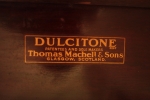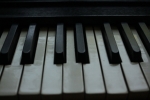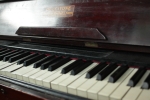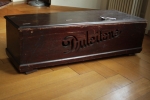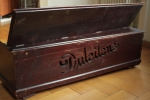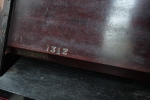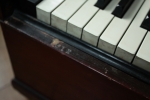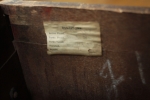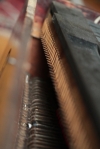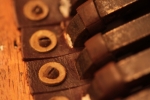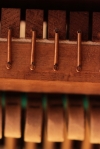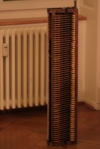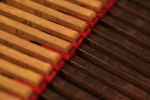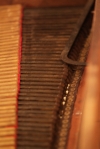OK, I’ve been meaning to post this for a while. Here at last are some pictures of my Dulcitone. And I’ll tell you most of what I’ve managed to glean largely from searching the internet pretty intensely. There is very little information on dulcitones and very few people know about them.
Apparently there were about 6000 made between about 1850-ish and 1910-ish. Mine is number 1312. You can see this clearly in a couple of the photos. There are an estimated 2000 surviving examples. So, it’s a fairly rare instrument. They were made in Glasgow, Scotland. That happens to be my hometown, so the lure of the dulctione was hard for me to resist with that in the mix. The really early ones just have “Thomas Machell” on them rather than “Thomas Machell & Sons”. I am led to believe the instrument narrowly missed the broader success of it’s cousin the celeste. Tchaikovski wrote his “dance of the sugar plum fairy” with a dulcitone in mind, but when it came to playing it with the orchestra the dulcitone was too quiet, so he went for the celeste instead. I can’t verify this but it’s a nice story anyway.
The instrument became quite popular with British missionaries for services out in the jungles, praries or wherever else they were spreading Christianity. It was relatively portable and didn’t go out of tune.
The instrument is a wooden box with tuning forks and so called “English action” keyboard in it. That is adapted from a grand piano that strikes the piano strings from above the strings rather than the usual below. When a dulcitone key is pressed it lifts a damper from the tuning fork allowing the note to sustain when it is struck. Depressing the key returns the damper to the tuning fork apart from when the sustain pedal is pressed. The sustain pedal lifts all the dampers from the tuning forks.
It is an ancestor of the electric Rhodes and Wurlitzer pianos still in use today. If you’ve ever played either instrument unplugged you would find the dulcitone very familiar. It turns up on a few recordings. I understand some of the Harry Potter film theme is recorded with a dulcitone. Marillion have used it in places, as has Fiona Apple, and some more modern folk records. And of course, now me. It’s well suited for a certain ambience as it has quite a mysterious, gentle but slightly screwed up sound to it. The closest thing to it soundwise is quite possibly a marimba but if you think somewhere between a glockenspiel and a piano you’re in the right area. The tuning on mine is well flat of today’s standard tuning. I’m not sure if this is because of a trend for today’s instruments to be tuned sharper, but if you want to play guitar with it you need to tune down a fair bit.
I found mine on eBay. It was a californian seller. He had acquired it in turn from an “English country hotel”. It was quite expensive in reality, more so with the shipping added on. I paid over a thousand dollars for it. I won’t even tell you about the repair bill. So, if you want one, you have to really want one. They are certainly difficult to find. They do turn up in auctions now and again. I’m guessing there could well be a few of these in grandparent’s attics in the United Kingdom. If you see one and it’s not too much I wouldn’t hesitate to snap it up. Then you can make a tidy sum selling it to idiots like me!
Normally the instrument has legs. As you can see mine doesn’t. You can tell it once had legs. Mine has been restored so as it plays pretty well. What I find slightly puzzling is that the restorer didn’t think it ever had a sustain pedal on it. I found the mechanism for this quite easily and have added my own temporary version which is basically just a chord that pulls the wooden bar connected to the dampers. Otherwise the restorer has done a good job.
One problem mine has is a buzz on a few of the notes. This is probably a soldering problem where the forks are joined to the metal coils on the soundboard. I have managed to minimize it considerably by cutting little rubber pieces and inserting them between the forks and the leather holders. That’s why you see those white pieces in some of the pictures here. I assume this will probably be a problem generally with dulcitones. I know it is a problem with Wurlitzer pianos too.
Transporting it is quite easy if you have a trolley. It weighs about 15 to 20 kilos. Certainly a good bit lighter than my preferred keyboard (Korg SV1). One problem is the dampers have an annoying tendency to slip beneath the tuning forks when you move it. They are quite tricky to pull back up. But I’ve worked out a way to avoid this by simply placing a long piece of card between the forks and the dampers during transit. That works well.
It seems to have acquired the nickname of “dead baby” in certain quarters. It’s similarity to a child’s coffin is quite clear. When I was busking with it a couple of days ago, I overheard a passerby refer to it as a child’s coffin. I guess it would be the perfect instrument for some neo folk gothic singer singwriter.
So, there you are. The dulcitone is a rather temperamental old dear, but as the name suggests a sweet one too.
I have a couple of tracks with this instrument on them. I also plan to do a video. That’s coming up, so watch this space.



